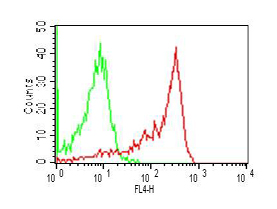
Intracellular flow cytometry analysis of TLR2 in PBMCs (Monocytes) using 0.5microg/106 cells of anti-TLR2, mAb (ABM3A87) (APC) (AG-20T-0300C). Green represents the isotype control; red represents APC-conjugated anti-TLR2, mAb (ABM3A87) (APC).
anti-TLR2, mAb (ABM3A87) (APC)

AG-20T-0300C
Overview
- SupplierAdipoGen Life Sciences
- Product Nameanti-TLR2, mAb (ABM3A87) (APC)
- Delivery Days Customer10
- Antibody SpecificityRecognizes human and mouse TLR2.
- ApplicationsFlow Cytometry
- CertificationResearch Use Only
- ClonalityMonoclonal
- Clone IDABM3A87
- Concentration0.2 mg/ml
- ConjugateAPC
- HostMouse
- IsotypeIgG1
- Scientific DescriptionMonoclonal Antibody. Recognizes human and mouse TLR2. Isotype: Mouse IgG1kappa. Clone: ABM3A87. Applications: FACS. Liquid. In PBS containing 0.05% sodium azide. TLR2 (Toll-like Receptor 2) is a member of the TLR (Toll-like receptor) family that plays a fundamental role in pathogen recognition and activation of innate immunity. TLR2 acts via MYD88 and TRAF6, leading to NF-kappaB activation, cytokine secretion and the inflammatory response. TLR2 resides on the plasma membrane where it responds to lipid-containing pathogen-associated molecular patterns (PAMPs), such as lipoteichoic acid and di- and tri-acylated cysteine-containing lipopeptides. It does this by forming dimeric complexes with either TLR1 or TLR6, which consequently is the initial step in a cascade of events leading to significant innate immune responses, development of adaptive immunity to pathogens and protection from immune sequelae related to infections with these pathogens. TLR2 also interacts with a large number of non-TLR molecules such as LY96 (MD-2), allowing for recognition of a great number and variety of PAMPs (pathogen-associated molecular patterns). TLR2 expression has been detected in immune cells, endothelial and epithelial cells. - TLR2 (Toll-like Receptor 2) is a member of the TLR (Toll-like receptor) family that plays a fundamental role in pathogen recognition and activation of innate immunity. TLR2 acts via MYD88 and TRAF6, leading to NF-kappaB activation, cytokine secretion and the inflammatory response. TLR2 resides on the plasma membrane where it responds to lipid-containing pathogen-associated molecular patterns (PAMPs), such as lipoteichoic acid and di- and tri-acylated cysteine-containing lipopeptides. It does this by forming dimeric complexes with either TLR1 or TLR6, which consequently is the initial step in a cascade of events leading to significant innate immune responses, development of adaptive immunity to pathogens and protection from immune sequelae related to infections with these pathogens. TLR2 also interacts with a large number of non-TLR molecules such as LY96 (MD-2), allowing for recognition of a great number and variety of PAMPs (pathogen-associated molecular patterns). TLR2 expression has been detected in immune cells, endothelial and epithelial cells.
- ReactivityHuman, Mouse
- Storage Instruction2°C to 8°C
- UNSPSC12352203
